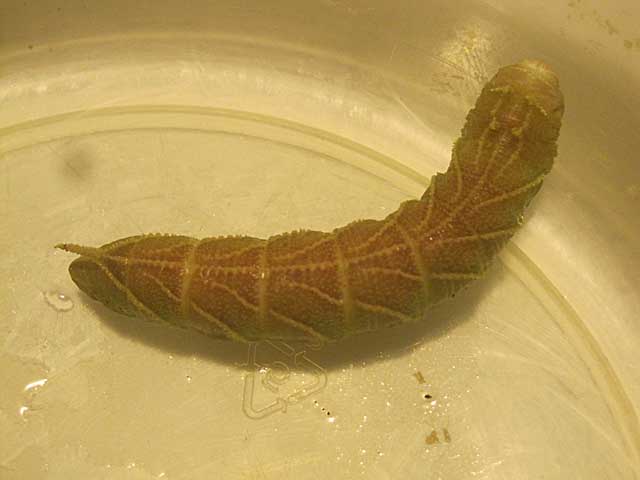Ceratomia amyntor
seer-a-TOHM-ee-uhM uh-MIN-tor
The Elm Sphinx or Four-horned
Sphinx
(Geyer, [1835]) Agrius amyntor


Mike observes: "Katya Epstein and I wrote you some years ago when we found an Abbott's Sphinx on the Plateau in Montreal. Now I've found an awesome caterpillar
which I suspect is a Sphinx of some kind. It didn't exactly match any of the ones in your list, though it was quite similar to some.
"I found it crawling on the sidewalk after a rain on St. Urbain St. in the Plateau Mont-Royal district of Montreal at about 11:15 pm tonight. It's about 3.25 inches
long, almost half an inch thick and more of a pale green than the photographs show. It has the funny spiky tail thing that I see in many of the other Sphinxes,
but also has four little horns at the front, two on the second segment behind the head and two on the third. There's a dorsal ridge of little pointy bumps
running from behind the "horns" to the tail spike. Its six little front feet have darker tips.
"I'd love to know what to feed him (or her) and how to help him achieve mothhood. My six-year-old daughter will be enthralled.
"Thanks for your help!"
"Your page here (http://www.silkmoths.bizland.com/camyntor.htm) says a dark bucket with paper towels will suffice for pupation, but I'm wondering how moist things
should be and what temperatures are optimal. Also, do I just feed him elm leaves until he's ready to pupate? When is that likely to be and when will he emerge? Does
the fact that he came down from the tree imply that he's ready now?
"You must get lots of letters like mine at this time of year. Thanks for your patience."
I respond, "Hi Mike,
"Yes, it is Ceratomia amyntor. Yes, it is ready to pupate. Probably a day or so before you found it, it was green and was feeding on foliage. Color change
and departure from tree are indicative that the larva has matured and is ready to pupate.
"A dark bucket and paper towels will suffice. You could also use a much smaller container. For the Sphingidae I reared here this summer, I used sandwich sized
Tupperware type containers with snap on lids. Specifically they were Gladware brand with clear plasic tub and translucent blue lids. I put a single folded (in half
lengthwise, then in half width wise) sheet of paper towel in each tub, inserted five to six modesta or cerisyi larvae in each tub, snapped the lid shut with no
moisture added and then in four to five days the larvae had pupated. They will give off moisture themselves inside the tub and the paper towel will likely
become moist. Room temperature if fine for pupation.
"The adult moth will not emerge this summer/fall, but is geared to overwinter.
I will shortly send you URL for a page where overwintering instructions are give.
For care of "found larvae/caterpillars" visit Manduca sexta larva, central Texas, August
21, 2008, Trina Woodall. The article includes overwintering instructions.
"Best of luck.
"I am going to add at least one of your images, credited to you, to my Quebec page. Hope that is okay??"
Use your browser "Back" button to return to the previous page.
Return to U.S.A. Table
Return to Sphingidae Index
Return to Sphingini Tribe